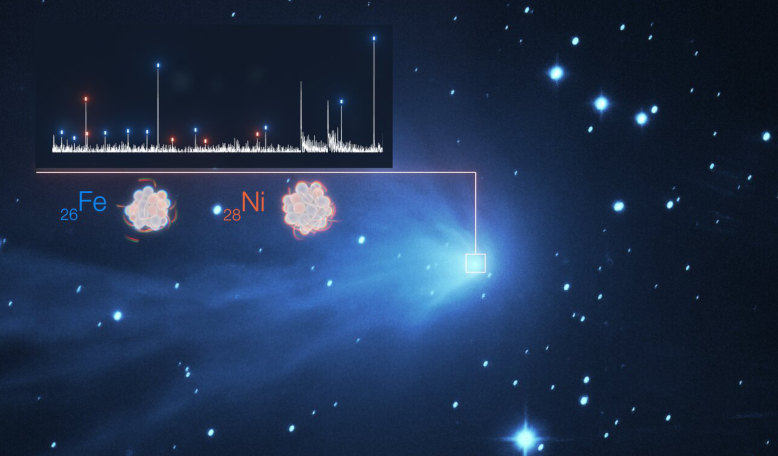The vapour from two heavy metals, the type usually associated with hot environments, has been found in the atmospheres of comets that stray far from the Sun say scientists. Not only has gaseous iron and nickel been found in comets originating from the outer Solar System, but gaseous nickel has also been detected surrounding comet 2I/Borisov, the second observed interstellar interloper after ʻOumuamua.
Ranging in size from a few hundred meters to loosely packed balls of ice and dust tens of kilometers across, comets heat up as they approach the sun and spew out gases and dust from their surface to form a tail that can stretch across millions of kilometres of space.
These gases, which also surround the comet in its coma, usually consist of oxygen, carbon and the constituents of water – material left over from when the planets formed – such as carbon dioxide (CO2), carbon monoxide (CO), methane (CH4), and ammonia (NH3).
Even when close to the Sun, these gases do not change much in composition because the bulk of the icy material the comets are made of, is largely hydrocarbons.
But, hidden deep in the cores of comets are metals. These are not usually seen, especially not far from the Sun, as solid metals don’t usually “sublimate” (become gaseous) at low temperatures.
However, in a new study by a Belgian team using the European Southern Observatory’s Very Large Telescope (ESO’s VLT), the data has shown traces of iron and nickel in the atmospheres of comets at distances of more than 480 million kilometres from the Sun. That is more than three times the Earth-Sun distance.
“It was a big surprise to detect iron and nickel atoms in the atmosphere of all the comets we have observed in the last two decades, about 20 of them, and even in ones far from the Sun in the cold space environment," says Jean Manfroid from the University of Liège, Belgium, who lead the new study on Solar System comets published today in Nature.
Only very small amounts of iron and nickel were found and the team estimates that for each 100 kilograms of water in the comets’ atmospheres there is only 1 gram of iron, and about the same amount of nickel.
Finding both iron and nickel in approximately equal amounts is curious say the team, as material in our Solar System, for example that found in the Sun and in meteorites, usually contains about ten times more iron than nickel.
The team suggest this might be due to a special kind of material on the surface of the comet nucleus, sublimating at a rather low temperature and releasing iron and nickel in about the same proportions, explains Damien Hutsemékers, also a member of the Belgian team from the University of Liège.
Although it is not clear what this material might be, advances in astronomy — such as the Mid-infrared ELT Imager and Spectrograph (METIS) on ESO’s upcoming Extremely Large Telescope (ELT) — will allow researchers to confirm the source of the iron and nickel atoms found in the atmospheres of these comets.
In another remarkable study published today in Nature, a Polish team of astronomers have detected gaseous nickel in the cold atmosphere of 2I/Borisov; the first alien comet to visit our Solar System.
“At first we had a hard time believing that atomic nickel could really be present in 2I/Borisov that far from the Sun. It took numerous tests and checks before we could finally convince ourselves,” says study author Piotr Guzik from the Jagiellonian University in Poland.
Both team’s finding are surprising as until now gases with heavy metal atoms had only been observed in hot environments, such as in the atmospheres of ultra-hot exoplanets or evaporating comets that passed too close to the Sun.
Guzik and colleagues observed 2I/Borisov when it was some 300 million kilometres away from the Sun, or about twice the Earth-Sun distance.
Detecting nickel stored within comet 2I/Borisov not only gives scientists a peek into the chemical make-up of the alien planetary system it originated from, but also shows that the interloper and Solar System comets have even more in common than previously thought.
“All of a sudden we understood that gaseous nickel is present in cometary atmospheres in other corners of the Galaxy,” says co-author Michał Drahus, also from the Jagiellonian University. “How cool is that?”











